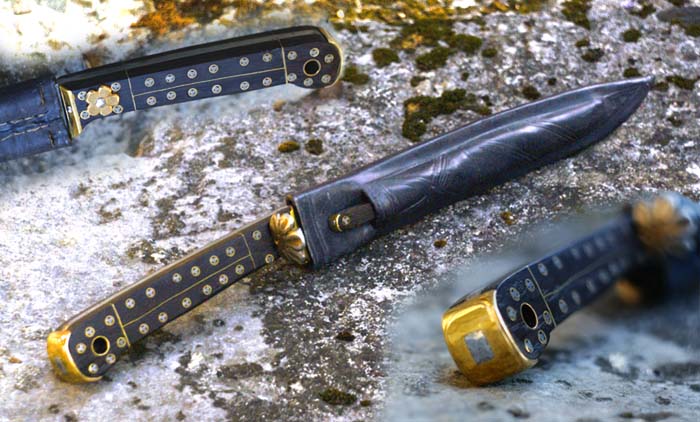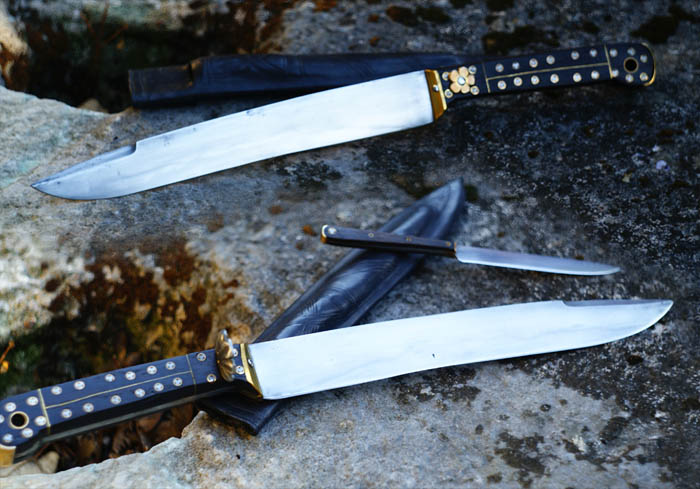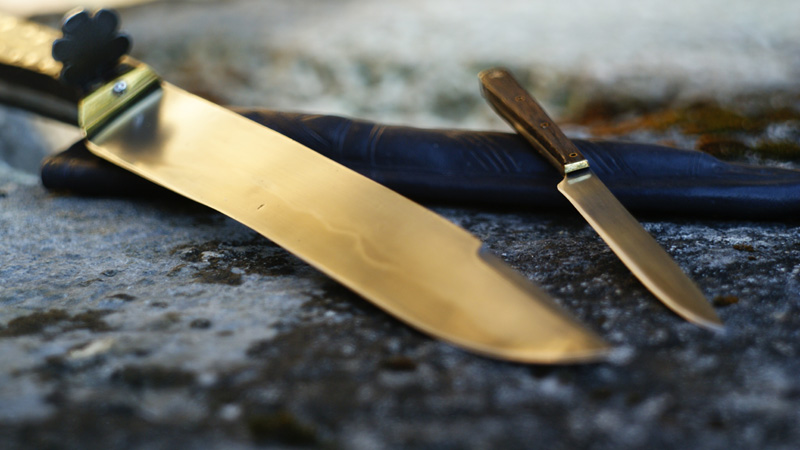| Author |
Message |
|
Fabrice Cognot
Industry Professional
|
 Posted: Fri 22 Oct, 2010 1:36 am Post subject: Bauernwehr Posted: Fri 22 Oct, 2010 1:36 am Post subject: Bauernwehr |
 |
|
Hi all
I've been away for a while, I know. I've been busy, but I also had the chance to meet some of the regular folks here 'in real life'.
....and now I'm back. With this little thing available :
A Bauernwehr. Late XVth century.
This piece is based on several models, but the main inspiration is a river-found knife kept at the Musée Denon in Châlon-sur-Saône, long (mis)identified as a "hunting knife" - though features from another knife in the same collection also appear on this re-creation.
As you all know, the Bauernwehr was very common in Germany, but several archaeological finds tend to indicate that their presence was far more widespread over Western Europe - the Châlon models were indeed found in the river Saône, and elements of knives of this type have also been found in the British Isles.
Most original Mediaeval knives show a composite construction, with a steel edge welded on an iron 'core' - thus saving the precious, expensive steel for the parts it would be the most useful. As steel is cheaper nowadays, the blade here is fully made of 1075 (XC75) Carbon steel, but I still wanted to keep as close to the original properties of Mediaeval knives, and went for a differential temper. Thus the edge area would be hard while the back would remain softer. You can see the temper line on one of the pics.
The short back edge is sharp, and was ground in as was the common practice at the time.
The main element that was borrowed from knife 83.19.1 of the Denon Museum is the handle and its very specific construction : four parts of wood on each side, separated by several strips of thin brass foil that also serve as spacers between the scales and the tang itself. Or in other words : the brass foil form some kind of 'casing' around each piece of wood. For instance, on the long, horizontal wooden parts, a first strip sits between the tang and wood, and is folded 90° to also serve as a spacer betwen the upper and lower wooden parts - and the same goes for the latter (lower) part.
Studying the original examples also show the shortcuts they used at the time - so there was no reason I should be ashamed of doing the same. Therefore instead of drilling or punching individual holes in these straps for each of the rivets, thin bands were cut off where the said rivets would be.
The rivets themselves are fancier than on the original. I opted for mosaic pins with a triangular pattern very popular in the late XVth century, especially on weapons. They were made of 4 mm diameter brass tubing with steel nails inserted - but each of them had to be filed to measure, as there were no nail of the adequate diameter commercialy available to me.
I gave the Nagel a fileworked, flowery shape to echo the shape of the brass flower on the other side. On knife 83-19-1, only the latter remains, but a strong, square-section (and broken) rod is still clearly visible coming through the tang from his flower. The brass bolsters and large 'pommel' rivet are a direct copy of 83-19-1, though the end brass plate is slightly larger (yet heavily inspired by...).
A by-knife, with the uppermost rivet also given this trifoil shape, serves as a companion to this Bauernwehr. Walnut wood was used on both knives for its rich, dark brown colour.
The scabbard is vegetable, naturally-coloured, hand-tooled leather.
It's available at 590 € plus shipping.
 Attachment: 95.88 KB Attachment: 95.88 KB

 Attachment: 99.44 KB Attachment: 99.44 KB

 Attachment: 116.38 KB Attachment: 116.38 KB

PhD in medieval archeology.
HEMAC member
De Taille et d'Estoc director
Maker of high quality historical-inspired pieces.
|
|
   |
 |
Nathan Robinson
myArmoury Admin


|
|
    |
 |
|
Fabrice Cognot
Industry Professional
|
|
   |
 |
|
Matthew Stagmer
Industry Professional
|
 Posted: Fri 22 Oct, 2010 5:56 am Post subject: Posted: Fri 22 Oct, 2010 5:56 am Post subject: |
 |
|
Beautiful work Fabrice. Looks like it was taken out of a museum. Well done indeed! Thanks for sharing.
Matthew Stagmer
Maker of custom and production weaponry
Youtube.com/ThatWorks
|
|
   |
 |
Sean Flynt

|
|
   |
 |
Julien M

|
 Posted: Fri 22 Oct, 2010 7:00 am Post subject: Posted: Fri 22 Oct, 2010 7:00 am Post subject: |
 |
|
Ravissant Mr Cognot!...that must be the best I've seen from you so far.
Cheers,
Julien
|
|
  |
 |
Paul Hansen

|
 Posted: Fri 22 Oct, 2010 8:46 am Post subject: Posted: Fri 22 Oct, 2010 8:46 am Post subject: |
 |
|
Really nice work Fabrice! 
|
|
  |
 |
Leo Todeschini
Industry Professional

|
 Posted: Fri 22 Oct, 2010 11:33 am Post subject: Posted: Fri 22 Oct, 2010 11:33 am Post subject: |
 |
|
I will join the queue - Lovely work. A very nice piece.
Good to meet you this summer and as you say meet you in real life.
| Quote: | | Fabrice Cognot wrote The rivets themselves are fancier than on the original. I opted for mosaic pins with a triangular pattern very popular in the late XVth century, |
other than cinquedea I cannot think of a mosaic pins, were these common on knives and swords? I must have just missed them, but that is a lovely way to decorate a piece and a great choice to make on your part.
Really well done
Tod
www.todsworkshop.com
www.todcutler.com
www.instagram.com/todsworkshop
https://www.facebook.com/TodsWorkshop
www.youtube.com/user/todsstuff1
|
|
   |
 |
|
Peter Lyon
Industry Professional
|
 Posted: Fri 22 Oct, 2010 11:42 am Post subject: Posted: Fri 22 Oct, 2010 11:42 am Post subject: |
 |
|
Gorgeous. I look forward to seeing more of your work.
Still hammering away
|
|
  |
 |
|
Hadrian Coffin
Industry Professional
|
 Posted: Fri 22 Oct, 2010 12:13 pm Post subject: Posted: Fri 22 Oct, 2010 12:13 pm Post subject: |
 |
|
Hello,
Looks absolutely lovely!
| Quote: | | and elements of knives of this type have also been found in the British Isles. |
I have a bauernwehr in my collection 15th century found in Yorkshire, England.
Best,
Hadrian
Historia magistra vitae est
|
|
   |
 |
|
Fabrice Cognot
Industry Professional
|
 Posted: Fri 22 Oct, 2010 12:26 pm Post subject: Posted: Fri 22 Oct, 2010 12:26 pm Post subject: |
 |
|
| Leo Todeschini wrote: | | other than cinquedea I cannot think of a mosaic pins, were these common on knives and swords? |
Oh, you are absloutely right : as you say they were more than rare - in fact apart from a few late period roundel daggers or long knife pommels, and a few concentric pins (ie a bar in a tube) these are practically unknown.
But the original plain rods would have been, well, too plain  . And I wanted to give this knife a special feature that I could repeat on the by-knife, without going for end caps or pommels (as I quite liked the shape of the final brass plate on the original). . And I wanted to give this knife a special feature that I could repeat on the by-knife, without going for end caps or pommels (as I quite liked the shape of the final brass plate on the original).
And thanks for the kind words - to all 
PhD in medieval archeology.
HEMAC member
De Taille et d'Estoc director
Maker of high quality historical-inspired pieces.
|
|
   |
 |
|
|

